formerly eScholarship Editions


|
|
|
|
Your search for architecture in text, title, author, description found 929 book(s). | Modify Search | Displaying 21 - 40 of 929 book(s) | |
| 21. | 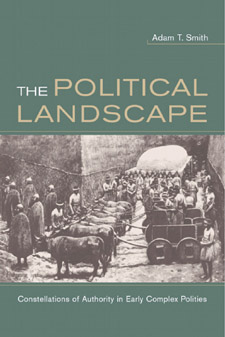 | Title: The political landscape: constellations of authority in early complex polities Author: Smith, Adam T Published: University of California Press, 2003 Subjects: Anthropology | Archaeology | Political Theory | Geography Publisher's Description: How do landscapes - defined in the broadest sense to incorporate the physical contours of the built environment, the aesthetics of form, and the imaginative reflections of spatial representations - contribute to the making of politics? Shifting through the archaeological, epigraphic, and artistic remains of early complex societies, this provocative and far-reaching book is the first systematic attempt to explain the links between spatial organization and politics from an anthropological point of view. The Classic-period Maya, the kingdom of Urartu, and the cities of early southern Mesopotamia provide the focal points for this multidimensional account of human polities. Are the cities and villages in which we live and work, the lands that are woven into our senses of cultural and personal identity, and the national territories we occupy merely stages on which historical processes and political rituals are enacted? Or do the forms of buildings and streets, the evocative sensibilities of architecture and vista, the aesthetics of place conjured in art and media constitute political landscapes - broad sets of spatial practices critical to the formation, operation, and overthrow of polities, regimes, and institutions? Smith brings together contemporary theoretical developments from geography and social theory with anthropological perspectives and archaeological data to pursue these questions. [brief] Matches in book (107): ...Gate). (All photographs by author. ) architecture, the physical organization of... Similar Items...277–83 . Forbes, T. 1983 . Urartian Architecture . Oxford : BAR International .... ...Designing Disney's Theme Parks: The Architecture of Re-assurance . Montréal :... |
| 22. | 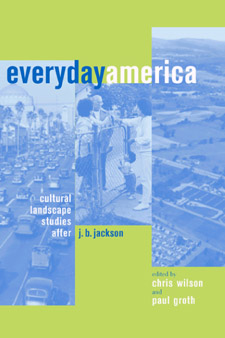 | Title: Everyday America: cultural landscape studies after J.B. Jackson Author: Wilson, Chris 1951 Dec. 23- Published: University of California Press, 2003 Subjects: Architecture | Landscape Architecture | Geography | American Studies | Urban Studies Publisher's Description: As old as a roadway that was once a Native trail, as new as the suburban subdivisions spreading across the American countryside, the cultural landscape is endlessly changing. The study of cultural landscapes - a far more recent development - has also undergone great changes, ever broadening, deepening, and refining our understanding of the intricate webs of social and ecological spaces that help to define human groups and their activities. Everyday America surveys the widening conceptions and applications of cultural landscape writing in the United States and, in doing so, offers a clear and compelling view of the state of cultural landscape studies today. These essays - by distinguished journalists, historians, cultural geographers, architects, landscape architects, and planners - constitute a critical evaluation of the field's theoretical assumptions, and of the work of John Brinckerhoff Jackson, the pivotal figure in the emergence of cultural landscape studies. At the same time, they present exemplary studies of twentieth-century landscapes, from the turn-of-the-century American downtown to the corporate campus and the mini-mall. Assessing the field's accomplishments and shortcomings, offering insights into teaching the subject, and charting new directions for its future development, Everyday America is an eloquent statement of the meaning, value, and potential of the close study of human environments as they embody, reflect, and reveal American culture. [brief] Matches in book (235): ...J.B. JACKSON AS A CRITIC OF MODERN ARCHITECTURE... Similar Items...3. HOROWITZ, "J.B. JACKSON AS A CRITIC OF MODERN ARCHITECTURE"... ...elements" into concrete methods that architecture students can apply directly... |
| 23. | 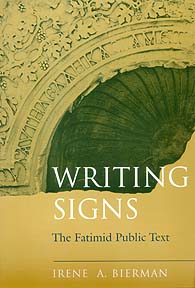 | Title: Writing signs: the Fatimid public text Author: Bierman, Irene A Published: University of California Press, 1998 Subjects: Art | Middle Eastern Studies | Middle Eastern History | Literature Publisher's Description: Irene Bierman explores the complex relationship between alphabet and language as well as the ways the two elements are socially defined by time and place. She focuses her exploration on the Eastern Mediterranean in the sixth through twelfth centuries, notably Cairo's Fatimid dynasty of 969-1171. Examining the inscriptions on Fatimid architecture and textiles, Bierman offers insight into all elements of that society, from religion to the economy, and the enormous changes the dynasty underwent during that period. Bierman addresses fundamental issues of what buildings mean, how inscriptions affect that meaning, and the role of written messages and the ceremonies into which they are incorporated in service of propagandist goals. Her method and conclusions provide a pioneering model for studying public writing in other societies and offer powerful evidence to show that writing is a highly charged and deeply embedded social practice. [brief] Matches in book (42): ...Inscriptionum Arabicarum EMA Creswell, Early Muslim Architecture MAE Creswell,... Similar Items...The Muslim Architecture of Egypt RCEA Institut français d’archéologie orientale... ...EMA , vol. 1. C. Mango, Byzantine Architecture (New York: Abrams, 1976), 98,... |
| 24. |  | Title: Symbolist art theories: a critical anthology Author: Dorra, Henri 1924- Published: University of California Press, 1995 Subjects: Art | Art History | Art Theory | Art Criticism Publisher's Description: Henri Dorra, in his comprehensive new book, presents the development and the aesthetic theories of the symbolist movement in art and literature. Included are writings (many never before translated or reprinted) by artists, designers, architects, and critics, along with Dorra's learned commentary. Fifty photographs of symbolist works complement his encyclopedic coverage.Dorra traces symbolism and its roots from artist to artist and critic to critic from the 1860s to the early twentieth century. The decorative arts and architecture are examined as well as painting and sculpture. The Arts and Crafts movement, art nouveau, the work of Eiffel in France and Sullivan in the United States are all well represented.The close relations between symbolist poets and artists are reflected in the chapter on literary developments. Baudelaire, Rimbaud, Verlaine, and Mallarmé are here, but so, too, are writers less well-known. A section on the Post-Impressionists and the "Artists of the Soul" rounds out Dorra's rich and varied text, and his epilogue lays the groundwork for what was to follow symbolism.Dorra beautifully integrates the different aesthetic branches of symbolism, the different media and national variations, without ever losing sight of the whole. The historical context provided makes this a particularly appealing collection for students and scholars of art history and literature, as well as for anyone interested in the evolution of symbolism. [brief] Matches in book (46): ...Ornament in Architecture (1892)... Similar Items...Ornament in Architecture (1892)... ...2— DECORATIVE ARTS AND ARCHITECTURE... |
| 25. | 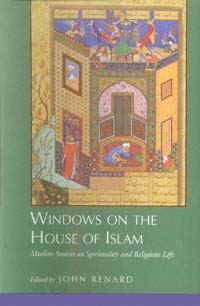 | Title: Windows on the house of Islam: Muslim sources on spirituality and religious life Author: Renard, John 1944- Published: University of California Press, 1998 Subjects: Religion | Middle Eastern Studies | History | Islam Publisher's Description: Over the centuries and across the globe, Muslim authors and artists have given moving testimony to their experience of being members of the Islamic community. Their many vantage points come together in this collection, one that represents major Islamic groups from the past through the present and covers a range of themes essential to understanding Islamic spirituality and religious life. More than thirty leading Islam scholars present translations originating from a dozen languages, including Arabic, Persian, Chinese, and Indonesian. Texts include samples of virtually every major literary form of significance to the Muslim faith: the Qur'an, hadith, scriptural commentary, letters, treatises, lyric and didactic poetry, hagiography, historical chronicle, aphorism, endowment deeds, and personal diary entries. In addition, over five dozen illustrations thematically document a full range of artistic forms and historical periods, from ritual objects and architecture to manuscripts of religious texts. This volume and its companion, John Renard's 1996 book, Seven Doors to Islam , are the only books available that integrate such a wide range of Islamic literary and visual forms. Together they offer a superb introduction to the primary religious sources as well as a general understanding of Islamic spirituality and culture. [brief] Matches in book (49): ...Sacred Text and Architecture... Similar Items...Women as Patrons of Architecture... ...and burial are also vividly expressed in art and architecture (figs. 19–21).... |
| 26. | 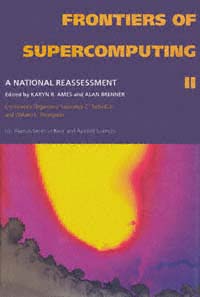 | Title: Frontiers of supercomputing II: a national reassessment Author: Ames, Karyn R Published: University of California Press, 1994 Subjects: Science | Computer Science | Physics Publisher's Description: This uniquely comprehensive book brings together the vast amount of technical, economic, and political information and the analyses of supercomputing that have hitherto been buried in the frequently inaccessible "gray literature." Seventy-nine distinguished participants in the second Frontiers of Su . . . [more] Matches in book (235): Similar Items |
| 27. | 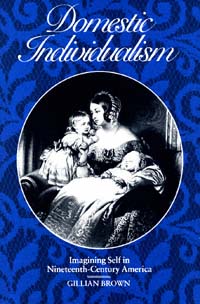 | Title: Domestic individualism: imagining self in nineteenth-century America Author: Brown, Gillian Published: University of California Press, 1992 Subjects: Literature | Literary Theory and Criticism | American Literature | Gender Studies | United States History | American Studies Publisher's Description: Gillian Brown's book probes the key relationship between domestic ideology and formulations of the self in nineteenth-century America. Arguing that domesticity institutes gender, class, and racial distinctions that govern masculine as well as feminine identity, Brown brilliantly alters, for literary critics, feminists, and cultural historians, the critical perspective from which nineteenth-century American literature and culture have been viewed.In this study of the domestic constitution of individualism, Brown traces how the values of interiority, order, privacy, and enclosure associated with the American home come to define selfhood in general. By analyzing writings by Stowe, Hawthorne, Melville, Fern, and Gilman, and by examining other contemporary cultural modes - abolitionism, consumerism, architecture, interior decorating, motherhood, mesmerism, hysteria, and agoraphobia - she reconfigures the parameters of both domesticity and the patterns of self it fashions. Unfolding a representational history of the domestic, Brown's work offers striking new readings of the literary texts as well as of the cultural contexts that they embody. [brief] Matches in book (40): ...of, 19 -20; in Gothic Revival architecture, 77 ; political economy of, 14 -16,... Similar Items...Cabin as, 36 , 37 Gothic Revival architecture, 71 -77 Grimke, Angelina, 26 -27,... ...of, 229 n7; and Gothic Revival architecture, 72 , 93 ; in House of the Seven... |
| 28. | 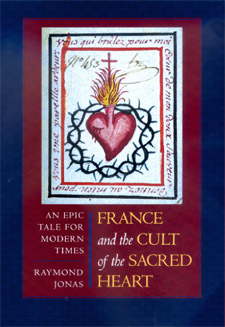 | Title: France and the cult of the Sacred Heart: an epic tale for modern times Author: Jonas, Raymond Anthony Published: University of California Press, 2000 Subjects: History | Religion | French Studies Publisher's Description: In a richly layered and beautifully illustrated narrative, Raymond Jonas tells the fascinating and surprisingly little-known story of the Sacré-Coeur, or Sacred Heart. The highest point in Paris and a celebrated tourist destination, the white-domed basilica of Sacré-Coeur on Montmartre is a key monument both to French Catholicism and to French national identity. Jonas masterfully reconstructs the history of the devotion responsible for the basilica, beginning with the apparition of the Sacred Heart to Marguerite Marie Alacoque in the seventeenth century, through the French Revolution and its aftermath, to the construction of the monumental church that has loomed over Paris since the end of the nineteenth century. Jonas focuses on key moments in the development of the cult: the founding apparition, its invocation during the plague of Marseilles, its adaptation as a royalist symbol during the French Revolution, and its elevation to a central position in Catholic devotional and political life in the crisis surrounding the Franco-Prussian War. He draws on a wealth of archival sources to produce a learned yet accessible narrative that encompasses a remarkable sweep of French politics, history, architecture, and art. [brief] Matches in book (37): ...Bataille, Georges . Against Architecture: The Writings of Georges Bataille .... Similar Items...Early Christian and Byzantine Architecture . Harmondsworth : Penguin , 1975 .... ...Labrouste and the Neo-Grec . In The Architecture of the Ecole des Beaux-Arts ,... |
| 29. | 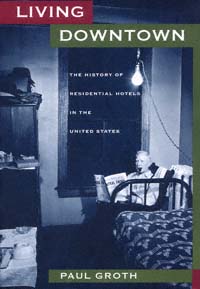 | Title: Living downtown: the history of residential hotels in the United States Author: Groth, Paul Erling Published: University of California Press, 1994 Subjects: Architecture | Urban Studies | Sociology Publisher's Description: From the palace hotels of the elite to cheap lodging houses, residential hotels have been an element of American urban life for nearly two hundred years. Since 1870, however, they have been the target of an official war led by people whose concept of home does not include the hotel. Do these residences constitute an essential housing resource, or are they, as charged, a public nuisance? Living Downtown , the first comprehensive social and cultural history of life in American residential hotels, adds a much-needed historical perspective to this ongoing debate. Creatively combining evidence from biographies, buildings and urban neighborhoods, workplace records, and housing policies, Paul Groth provides a definitive analysis of life in four price-differentiated types of downtown residence. He demonstrates that these hotels have played a valuable socioeconomic role as home to both long-term residents and temporary laborers. Also, the convenience of hotels has made them the residence of choice for a surprising number of Americans, from hobo author Boxcar Bertha to Calvin Coolidge.Groth examines the social and cultural objections to hotel households and the increasing efforts to eliminate them, which have led to the seemingly irrational destruction of millions of such housing units since 1960. He argues convincingly that these efforts have been a leading contributor to urban homelessness.This highly original and timely work aims to expand the concept of the American home and to recast accepted notions about the relationships among urban life, architecture, and the public management of residential environments. [brief] Matches in book (35): ...235 –236, 242 , 244 Vernacular architecture, x –xi, 18 Vice districts, 120 –121,... Similar Items...Ellen Hayward, "Urban Vernacular Architecture in Nineteenth-Century Baltimore,"... ...and commercial socializing. The architecture of the no-family house also... |
| 30. | 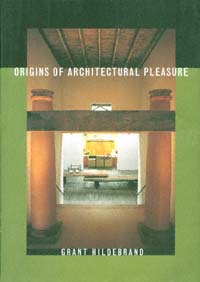 | Title: Origins of architectural pleasure Author: Hildebrand, Grant 1934- Published: University of California Press, 1999 Subjects: Architecture | Environmental Studies | Psychology Publisher's Description: Do survival instincts have anything to do with our architectural choices - our liking for a certain room, a special stairway, a plaza in a particular city? In this engaging study Grant Hildebrand discusses ways in which architectural forms emulate some archetypal settings that humans have found appealing - and useful to survival - from ancient times to the present.Speculating that nature has "designed" us to prefer certain conditions and experiences, Hildebrand is interested in how the characteristics of our most satisfying built environments mesh with Darwinian selection. In examining the appeal of such survival-based characteristics he cites architectural examples spanning five continents and five millennia. Among those included are the Palace of Minos, the Alhambra, Wells cathedral, the Shinto shrine at Ise, the Piazza San Marco, Brunelleschi's Pazzi Chapel, Frank Lloyd Wright's Fallingwater, a Seattle condominium, and recent houses by Eric Owen Moss and Arne Bystrom.Just what characteristics bestow evolutionary benefits? "Refuge and prospect" offer a protective place of concealment close to a foraging and hunting ground. "Enticement" invites the safe exploration of an information-rich setting where worthwhile discoveries await. "Peril" elicits an emotion of pleasurable fear and so tests and increases our competence in the face of danger: thus the attraction of a skyscraper or a house poised over a vertiginous ravine. "Order and complexity" tease our intuitions for sorting complex information into survival-useful categories.Gracefully written, with excellent illustrations that complement the text, Origins of Architectural Pleasure will open the reader's eyes to new ways of seeing a home, a workplace, a vacation setting, even a particular table in a restaurant. It also suggests important design considerations for buildings with a more pressing mandate for human appeal, such as hospitals, retirement homes, and hospices. [brief] Matches in book (90): ...The Unique Epitome of Perilous Architecture... Similar Items...The Refuge and the Prospect in Architecture... ...chronicle. 22. Vincent Scully, Architecture (New York: St. Martin's Press,... |
| 31. | 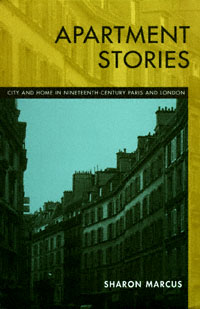 | Title: Apartment stories: city and home in nineteenth-century Paris and London Author: Marcus, Sharon 1966- Published: University of California Press, 1999 Subjects: Literature | European History | Urban Studies | Women's Studies Publisher's Description: In urban studies, the nineteenth century is the "age of great cities." In feminist studies, it is the era of the separate domestic sphere. But what of the city's homes? In the course of answering this question, Apartment Stories provides a singular and radically new framework for understanding the urban and the domestic. Turning to an element of the cityscape that is thoroughly familiar yet frequently overlooked, Sharon Marcus argues that the apartment house embodied the intersections of city and home, public and private, and masculine and feminine spheres.Moving deftly from novels to architectural treatises, legal debates, and popular urban observation, Marcus compares the representation of the apartment house in Paris and London. Along the way, she excavates the urban ghost tales that encoded Londoners' ambivalence about city dwellings; contends that Haussmannization enclosed Paris in a new regime of privacy; and locates a female counterpart to the flâneur and the omniscient realist narrator - the portière who supervised the apartment building. [brief] Matches in book (151): ...International, n.d. "English Domestic Architecture." The Builder 1, no. 36 (... Similar Items...S. H. Designs for Cottage and Villa Architecture . London: Thomas Kelly, n.d. [... ...1991. Brown, Richard. Domestic Architecture . London: George Virtue, 1841. "... |
| 32. |  | Title: Seven doors to Islam: spirituality and the religious life of Muslims Author: Renard, John 1944- Published: University of California Press, 1996 Subjects: Religion | Middle Eastern Studies | Middle Eastern History | Islam | Medieval Studies Publisher's Description: Seven Doors to Islam reveals the religious worldview and spiritual tradition of the world's one billion Muslims. Spanning the breadth of Islamic civilization from Morocco to Indonesia, this book demonstrates how Muslims have used the literary and visual arts in all their richness and diversity to communicate religious values. Each of the seven chapters opens a "door" that leads progressively closer to the very heart of Islam, from the foundational revelation in the Qur'an to the transcendent experience of the Sufi mystics. However, unlike most studies of Islam, which see spirituality as the concern of a minority of mystical seekers, Seven Doors demonstrates its central role in every aspect of the Islamic tradition. [brief] Matches in book (132): ...Art and Architecture... Similar Items...Art and Architecture... ...and spatial context that is exemplified in Islamic art and architecture.... |
| 33. | 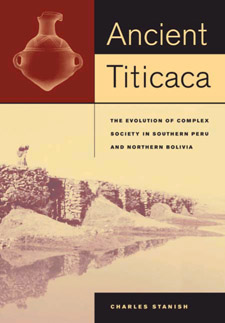 | Title: Ancient Titicaca: the evolution of complex society in southern Peru and northern Bolivia Author: Stanish, Charles 1956- Published: University of California Press, 2003 Subjects: Anthropology | Cultural Anthropology | Archaeology | Latin American Studies Publisher's Description: One of the richest and most complex civilizations in ancient America evolved around Lake Titicaca in southern Peru and northern Bolivia. This book is the first comprehensive synthesis of four thousand years of prehistory for the entire Titicaca region. It is a fascinating story of the transition from hunting and gathering to early agriculture, to the formation of the Tiwanaku and Pucara civilizations, and to the double conquest of the region, first by the powerful neighboring Inca in the fifteenth century and a century later by the Spanish Crown. Based on more than fifteen years of field research in Peru and Bolivia, Charles Stanish's book brings together a wide range of ethnographic, historical, and archaeological data, including material that has not yet been published. This landmark work brings the author's intimate knowledge of the ethnography and archaeology in this region to bear on major theoretical concerns in evolutionary anthropology. Stanish provides a broad comparative framework for evaluating how these complex societies developed. After giving an overview of the region's archaeology and cultural history, he discusses the history of archaeological research in the Titicaca Basin, as well as its geography, ecology, and ethnography. He then synthesizes the data from six archaeological periods in the Titicaca Basin within an evolutionary anthropological framework. Titicaca Basin prehistory has long been viewed through the lens of first Inca intellectuals and the Spanish state. This book demonstrates that the ancestors of the Aymara people of the Titicaca Basin rivaled the Incas in wealth, sophistication, and cultural genius. The provocative data and interpretations of this book will also make us think anew about the rise and fall of other civilizations throughout history. [brief] Matches in book (175): ...The Ideology of Imperial Expansion: Art and Architecture... Similar Items...A PROPOSED SEQUENCE OF ELITE STELAE AND ARCHITECTURE FOR THE FORMATIVE PERIOD... ...to form settlement clusters around larger sites with corporate architecture.... |
| 34. | 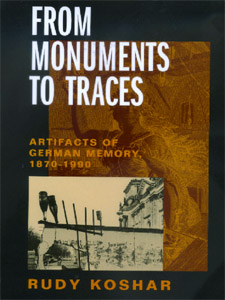 | Title: From monuments to traces: artifacts of German memory, 1870-1990 Author: Koshar, Rudy Published: University of California Press, 2000 Subjects: German Studies | History | Architectural History | European History Publisher's Description: Rudy Koshar constructs a powerful framework in which to examine the subject of German collective memory, which for more than a half century has been shaped by the experience of Nazism, World War II, and the Holocaust. Finding the assumptions of many writers and scholars shortsighted, Koshar surveys the evidence of postwar German memory in the context of previous traditions. From Monuments to Traces follows the evolution of German "memory landscapes" all the way from national unification in 1870-71 through the world wars and political division to reunification in 1990. The memory landscapes of any society may incorporate monuments, historical buildings, memorials and cemeteries, battlefields, streets, or natural environments that foster shared memories of important events or personalities. They may also be designed to divert public attention from embarrassing or traumatic histories. Koshar argues that in Germany, memory landscapes have taken shape according to four separate paradigms--the national monument, the ruin, the reconstruction, and the trace--which he analyzes in relation to the changing political agendas that have guided them over time. Despite the massive ruptures of Germany's history, we see that significant continuities have served to counterbalance the traumas of the German past. [brief] Matches in book (125): ...THE ARCHITECTURE OF MEMORY... Similar Items...Richard . Modernism in Italian Architecture, 1890–1940 . Cambridge, Mass. : MIT... ...Germany: The Case of Industrial Architecture . Oxford : Berg Publishers , 1995 .... |
| 35. | 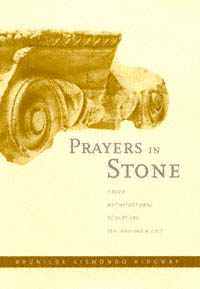 | Title: Prayers in stone: Greek architectural sculpture ca. 600-100 B.C.E Author: Ridgway, Brunilde Sismondo 1929- Published: University of California Press, 1999 Subjects: Classics | Art | Art and Architecture | Art History Publisher's Description: The meaning of architectural sculpture is essential to our understanding of ancient Greek culture. The embellishment of buildings was common for the ancient Greeks, and often provocative. Some ornamental sculpture was placed where, when the building was finished, no mortal eye could view it. And unlike much architectural ornamentation of other cultures, Greek sculpture was often integral to the building, not just as decoration, and could not be removed without affecting the integrity of the building structure. This book is the first comprehensive treatment of the significance of Greek architectural sculpture. Brunilde Sismondo Ridgway, a world-class authority on ancient Greek sculpture, provides a highly informative tour of many dimensions of Greek public buildings - especially temples, tombs, and treasuries - in a text that is at once lucid, accessible, and authoritative.Ridgway's pragmatism and common sense steer us tactfully and clearly through thickets of uncertainty and scholarly disagreement. She refers to a huge number of monuments, and documents her discussions with copious and up-to-date bibliographies. This book is sure to be acknowledged at once as the standard treatment of its important topic. [brief] Matches in book (98): ...Greek Architecture... Similar Items...frieze was ever realized in stone architecture is now impossible to tell. 58... ...polychromes." In Couleur et architecture ( IAS = Ingénieurs et architectes... |
| 36. | 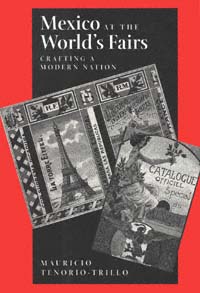 | Title: Mexico at the world's fairs: crafting a modern nation Author: Tenorio-Trillo, Mauricio 1962- Published: University of California Press, 1996 Subjects: History | Latin American History | Latin American Studies | Literature Publisher's Description: This intriguing study of Mexico's participation in world's fairs from 1889 to 1929 explores Mexico's self-presentation at these fairs as a reflection of the country's drive toward nationalization and a modernized image. Mauricio Tenorio-Trillo contrasts Mexico's presence at the 1889 Paris fair - where its display was the largest and most expensive Mexico has ever mounted - with Mexico's presence after the 1910 Mexican Revolution at fairs in Rio de Janeiro in 1922 and Seville in 1929.Rather than seeing the revolution as a sharp break, Tenorio-Trillo points to important continuities between the pre- and post-revolution periods. He also discusses how, internationally, the character of world's fairs was radically transformed during this time, from the Eiffel Tower prototype, encapsulating a wondrous symbolic universe, to the Disneyland model of commodified entertainment.Drawing on cultural, intellectual, urban, literary, social, and art histories, Tenorio-Trillo's thorough and imaginative study presents a broad cultural history of Mexico from 1880 to 1930, set within the context of the origins of Western nationalism, cosmopolitanism, and modernism. [brief] Matches in book (132): ...Seven Mexican Art and Architecture in Paris... Similar Items...Seven Mexican Art and Architecture in Paris... ...Zeynep. Displaying the Orient: Architecture of Islam at Nineteenth-Century... |
| 37. | 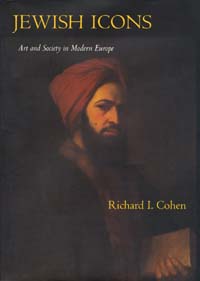 | Title: Jewish icons: art and society in modern Europe Author: Cohen, Richard I Published: University of California Press, 1998 Subjects: Art | Jewish Studies | European Studies | European History Publisher's Description: With the help of over one hundred illustrations spanning three centuries, Richard Cohen investigates the role of visual images in European Jewish history. The interaction of Jews with the visual arts takes place, as Cohen says, in a vast gallery of prints, portraits, books, synagogue architecture, ceremonial art, modern Jewish painting and sculpture, political broadsides, monuments, medals, and memorabilia. Pointing to recent scholarship that overturns the stereotype of Jews as people of the text, unconcerned with the visual, Cohen shows how the coming of the modern period expanded the relationship of Jews to the visual realm far beyond the religious context. Toward the end of the nineteenth century, the study and collecting of Jewish art became a legitimate and even passionate pursuit, and signaled the entry of Jews into the art world as painters, collectors, and dealers. [brief] Matches in book (11): ...105–111. ———. Synagogues of Europe: Architecture, History, Meaning . Cambridge,... Similar Items...200 , 203 , 204 , 208 , 239 ; architecture of, 5 , 8 ; behavior in Amsterdam,... ...H. Krinsky, Synagogues of Europe: Architecture, History, Meaning (Cambridge,... |
| 38. | 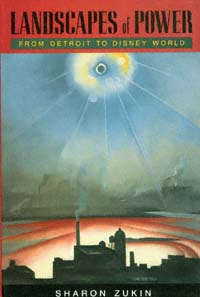 | Title: Landscapes of power: from Detroit to Disney World Author: Zukin, Sharon Published: University of California Press, 1993 Subjects: Politics | Politics | Postcolonial Studies | Urban Studies | Geography | Economics and Business Matches in book (103): ...Fantasy in Vernacular Architecture... Similar Items...256 Architects, 39 , 46 ; superstar, 47 -49. See also Architecture; names of... ...individual architects Architecture, 11 , 16 , 38 , 42 -48, 49 , 142 , 260 ;... |
| 39. | 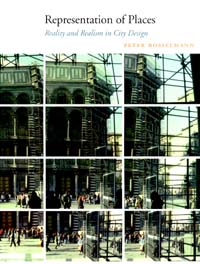 | Title: Representation of places: reality and realism in city design Author: Bosselmann, Peter Published: University of California Press, 1998 Subjects: Architecture | Architectural History | Urban Studies Publisher's Description: People live in cities and experience them firsthand, while urban designers explain cities conceptually. In Representation of Places Peter Bosselmann takes on the challenging question of how designers can communicate the changes they envision in order that "the rest of us" adequately understand how those changes will affect our lives. New modes of imaging technology - from two-dimensional maps, charts, and diagrams to computer models - allow professionals to explain their designs more clearly than ever before. Although architects and planners know how to read these representations, few outside the profession can interpret them, let alone understand what it would be like to walk along the streets such representations describe. Yet decisions on what gets built are significantly influenced by these very representations. A portion of Bosselmann's book is based on innovative experiments conducted at the University of California, Berkeley's Visual Simulation Laboratory. In a section titled "The City in the Laboratory," he discusses how visual simulation was applied to projects in New York City, San Francisco, and Toronto. The concerns that Bosselmann addresses have an impact on large segments of society, and lay readers as well as professionals will find much that is useful in his timely, accessibly written book. [brief] Matches in book (73): ...1976. Vitruvius. Ten Books of Architecture. Translated by Morris Hicky Morgan.... Similar Items...Taylor, 1803. Rossi, Aldo. The Architecture of the City. Cambridge: MIT Press,... ...Scruton, Roger. The Aesthetics in Architecture. Princeton, N.J. : Princeton... |
| 40. | 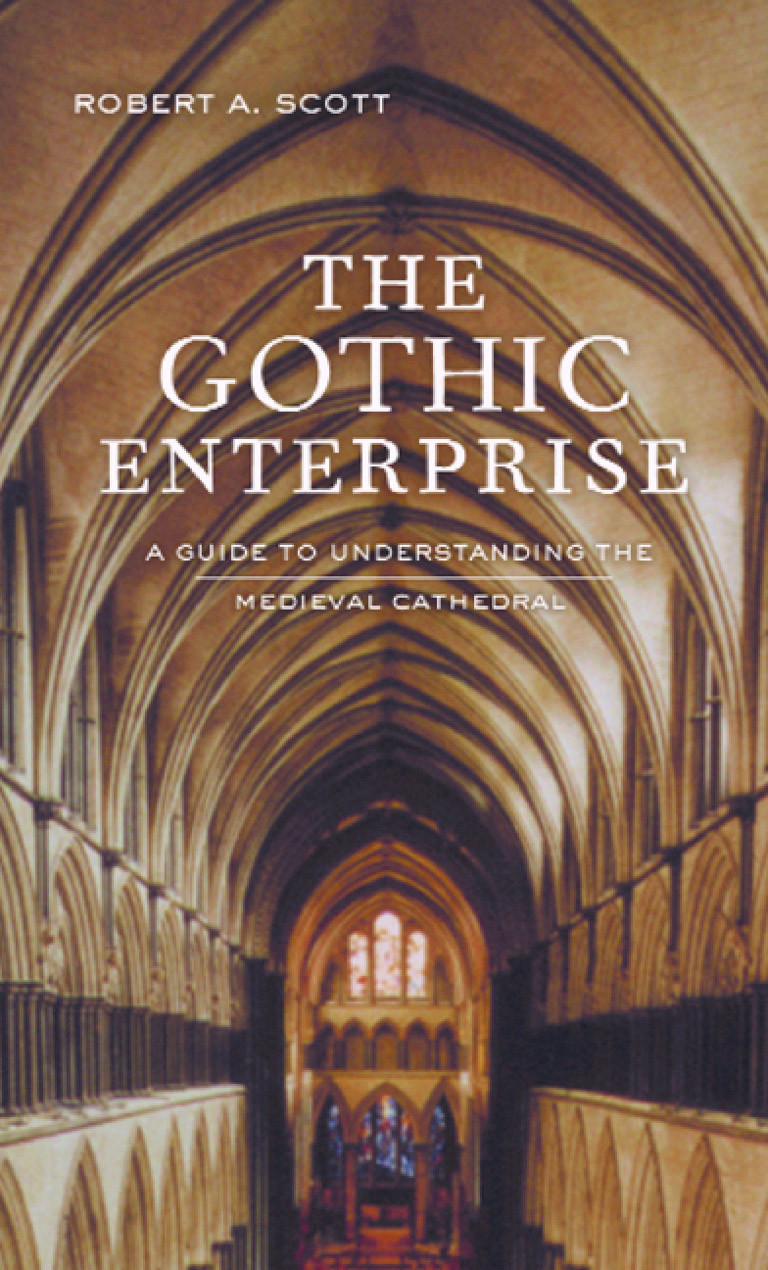 | Title: The Gothic enterprise: a guide to understanding the Medieval cathedral Author: Scott, Robert A 1935- Published: University of California Press, 2003 Subjects: Medieval Studies | Architecture | European Studies | Christianity | European History | Architectural History | Sociology | Sociology Publisher's Description: The great Gothic cathedrals of Europe are among the most astonishing achievements of Western culture. Evoking feelings of awe and humility, they make us want to understand what inspired the people who had the audacity to build them. This engrossing book surveys an era that has fired the historical imagination for centuries. In it Robert A. Scott explores why medieval people built Gothic cathedrals, how they built them, what conception of the divine lay behind their creation, and how religious and secular leaders used cathedrals for social and political purposes. As a traveler's companion or a rich source of knowledge for the armchair enthusiast, The Gothic Enterprise helps us understand how ordinary people managed such tremendous feats of physical and creative energy at a time when technology was rudimentary, famine and disease were rampant, the climate was often harsh, and communal life was unstable and incessantly violent. While most books about Gothic cathedrals focus on a particular building or on the cathedrals of a specific region, The Gothic Enterprise considers the idea of the cathedral as a humanly created space. Scott discusses why an impoverished people would commit so many social and personal resources to building something so physically stupendous and what this says about their ideas of the sacred, especially the vital role they ascribed to the divine as a protector against the dangers of everyday life. Scott's narrative offers a wealth of fascinating details concerning daily life during medieval times. The author describes the difficulties master-builders faced in scheduling construction that wouldn't be completed during their own lifetimes, how they managed without adequate numeric systems or paper on which to make detailed drawings, and how climate, natural disasters, wars, variations in the hours of daylight throughout the year, and the celebration of holy days affected the pace and timing of work. Scott also explains such things as the role of relics, the quarrying and transporting of stone, and the incessant conflict cathedral-building projects caused within their communities. Finally, by drawing comparisons between Gothic cathedrals and other monumental building projects, such as Stonehenge, Scott expands our understanding of the human impulses that shape our landscape. [brief] Matches in book (74): ...the Gothic Period, and Gothic Architecture, 218. Von Simson, Gothic Cathedral,... Similar Items...Royal Abbey, 1278–1280. ” Herbert A. Simon, “The Architecture of Complexity. ”... ...Erwin Panofsky, Gothic Architecture and Scholasticism, 46–47.... |